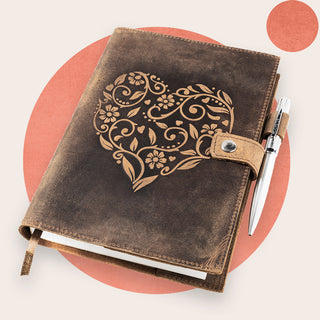Have you found yourself suddenly struck with an incorrigible sense of guilt at your lust for leather? Is leather sustainable? What kind of an effect is it having on the environment, the animals involved, and the people involved in bringing it to you?
Let's find out today as we explore the question of leather sustainability.
Leather is both sustainable and unsustainable - it could be a lot better. Let's see how.
What's the Lowdown?
Well, there are a whole bunch of people who would have you believe that the leather industry is incredibly sustainable and good for the environment and, while it does have its benefits, how can any self-respecting person lull themselves into believing this?
To counter the cruelty involved, leather production is oft-touted as providing a long-lasting, natural, and sometimes even biodegradable material. Is this true? And, if so, at what cost? Let's explore some of these costs in greater detail.

The Environmental Impact of Leather
This is a big one, especially in this day and age, and it is also incredibly multifaceted.
Deforestation
This is a serious issue throughout the fashion industry as there is an incredible reliance on unsustainable cellulose materials as harvested from logged, often old-growth trees.
Looking at the stats, it's no wonder many people shun the meat industry altogether and opt to wear vegan leather at most. 'As much as 80% of deforestation in the Amazon Rainforest is tied to cattle ranching.' There is clearly no forward planning involved in such an enterprise.
Greenhouse Gases
When you start to take a look at the carbon footprint of the various items in your wardrobe, the guilt begins to stack up and you start to wonder where it all went wrong. In fact, a pair of seemingly innocent cow-skin leather boots has a footprint (pardon the pun) of 66kg of CO2.
Seeing as cattle are ruminant animals that breathe, fart, and burp, they also release methane, a gas even more potent than CO2, meaning that they are one of the most significant contributors to our most serious environmental problems. This is, of course, not their fault, but rather a result of over-farming for gain.
Leather Processing
The production of leather is also incredibly water-intensive, regardless of whether you use vegetable-tanning methods or otherwise. Some more grave approximations believe that the creation of a cow-skin tote bag is equal to the use of more than 17,000 liters of water.
Even the manufacture of cotton and related products is water-intensive too, though leather is far worse. Not only is the amount of water used intensive but it is also left polluted by all sorts of harmful chemicals. This is where vegetable-tanned leather has the upper hand, for it is the chrome-tanning process that is most harmful.
Human Impact
It is also important to consider how the production of leather - excluding faux leather, of course - can impact the people surrounding it.
Tanners
Those who work tanning the leather are often exploited by their superiors despite the fact that they face serious health risks being around such a diabolic manufacturing process for most of their days.
In fact, their prospects look pretty grim when you weigh up the statistics - many are likely to die due to exposure to harmful, carcinogenic chemicals. There are even such places in China referred to as cancer villages wherein the pollution impact is so vast that it has altogether grave consequences.
Farmers
With farmers, it is more an issue of forced labor, so it's no wonder why many prefer to opt for more sustainable fashion. This isn't specific to the production of leather, though it is particularly bad since leather is still such a desirable commodity.
Labor trafficking, debt bondage, and modern slavery are just some of the after-effects of leather production, all of which have been recorded in leather hotspots like Brazil, Paraguay, and Vietnam. There is an overall lack of transparency throughout the leather supply chain, something that many big brands don't seem to give a hoot about.
Abattoir Workers
If you aren't already lusting after some proper leather alternatives, just wait until you get a load of this. It must not be forgotten that leather is produced in what is known as a slaughtering supply chain.
Those who work in a slaughterhouse are known to experience perpetration-induced stress, a condition similar to PTSD that comes from being the direct reason for another being's trauma. This alongside the many physical injuries should surely tell you how damaging this line of work can be.
Animal Impact
Of course, this is all to neglect the animals involved who, after experiencing similar traumas at the hands of these workers, are eventually slaughtered for capital gain.
To some, animals are clearly further down the food chain. There is, however, no doubt that they are sentient beings that are capable of various emotions and that are, ultimately, good for human health.
Much cattle doesn't live much beyond a few years when its actual lifespan is well into the 20s sometimes. It's no wonder, then, that many are opting more and more toward sustainable leather production for the benefit of animal welfare.
Ethical Leather
Nowadays, there are so-called standards and bits of legislation in place to help ensure that all of the above doesn't happen. And yet, it still does. What gives?
No matter how well-intentioned organizations like the Leather Working Group are, there are still countless loopholes in their work, allowing many bigger brands who use different methods to evade culpability.
Despite much research into more sustainable regenerative cultures and farming, little has been done to properly implement this into the day-to-day leather chain. It's all enough to make you lose hope entirely.
Final Words
So, there you have it! Hopefully, you are now feeling ready and able to enter back into the world with a newfound knowledge of leather sustainability, ready and willing to make an active change, too.
FAQs Is Leather Sustainable?
WHY ISN'T LEATHER SUSTAINABLE?
Leather could easily be made more sustainable but it seems that the current way of things benefits those in power too much for any dramatic shift to occur in the great chain of leather manufacture. The production of this material negatively affects just about every single person and creature in the supply chain to some extent except, of course, the big cheeses up top who are running the whole damn operation.
IS LEATHER AN UNSUSTAINABLE SOURCE OF MATERIAL?
Leather has great potential to be sustainable and, in fact, much research has gone into looking for new methods by which to farm this material that would be better for the environment. However, because these changes and the great shift necessary to implement them don't benefit those in power, things have remained stagnant since.



